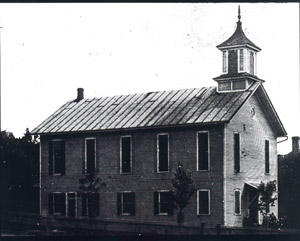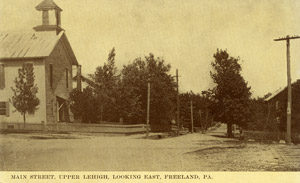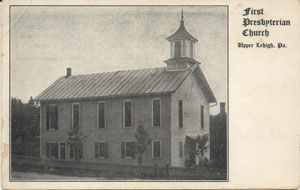
News & announcements
Saving your history
Early accounts
Maps
Nearby towns
People
Churches
Schools
Municipal
Organizations
Businesses
The mines
Transportation
Streets
Buildings
Entertainment
Celebrations
Sports
Ethnic groups
Upper Lehigh churches
What's on this page:
- Upper Lehigh Presbyterian Church
- Upper Lehigh Welsh Baptist Church
- Incorporation of the first Baptist church in Hazleton
- Other denominations
The photo at top left of the Upper Lehigh Presbyterian Church came from John Zubach.
From W. W. Munsell’s History of Luzerne, Lackawanna and Wyoming Counties, Pa., …, 1880:
[writing about Upper Lehigh] – “There are at this place two churches (Presbyterian and Welsh) and a Methodist Episcopal society without a church.”
[Note: I will say that there is something confusing to me in the historical notes about these two churches, because in the text shown below both Munsell (1880) and Bradsby (1893) said that Rev. John Johnson and Rev. George H. Hammer were involved in both churches. Rev. George Hammer was also said to have delivered the first sermon at the Trinity Methodist Church on Birkbeck Street. I don’t have any more information at present to clarify those notes but will update this when I do. – CT]
Upper Lehigh Presbyterian Church
 From W. W. Munsell’s History of Luzerne,
Lackawanna and Wyoming Counties, Pa., …, 1880:
From W. W. Munsell’s History of Luzerne,
Lackawanna and Wyoming Counties, Pa., …, 1880: “Presbyterian Church in Upper Lehigh - This church owes its origin at this place to members of the Upper Lehigh Coal Company who belonged to the Presbyterian Church previous to locating here. John Leisenring, now of Mauch Chunk but at the time referred to mining coal at Eckley, was the first to purchase the land on which the present church edifice is built. With him were associated such Christian gentlemen as Samuel B. Price, Daniel Bertsch, Jr., and Walter Leisenring. No sooner were the mines in full operation than these men set about securing a place of worship, not only for themselves but for those in their employ. For a time they were supplied alternately by Presbyterian and Methodist ministers, and used an extemporized house of worship. The church was formally organized June 28th, 1868, by a committee appointed by the Presbytery of Luzerne for that purpose, with the following members: Mrs. Harriet B. Price, Miss Leisenring, Parker Price, Mrs. Anna Oliver and Mrs. Mary Jamison. An election for elder was held, which resulted in the choice of Parker Price. The present church was built in 1871 at a cost for building and furnishing of about $4,500. The present value of the church property is $4,000.”
 Munsell: “Rev. John Johnson was the
minister who gathered a
nucleus for a church. With him Rev. Mr. Day, a Methodist minister,
labored in preaching the gospel. Mr. Johnson continued to supply the
pulpit, with the approval of the Presbytery, until the spring of 1870.
Nov. 1st, 1870, Rev. George H. Hammer commenced his labors as a supply,
which he continued until Nov. 18th, 1877. The present pastor, Rev. D.
McLeod, a member of the Presbytery of Hudson, N.Y., commenced his
labors as stated supply.”
Munsell: “Rev. John Johnson was the
minister who gathered a
nucleus for a church. With him Rev. Mr. Day, a Methodist minister,
labored in preaching the gospel. Mr. Johnson continued to supply the
pulpit, with the approval of the Presbytery, until the spring of 1870.
Nov. 1st, 1870, Rev. George H. Hammer commenced his labors as a supply,
which he continued until Nov. 18th, 1877. The present pastor, Rev. D.
McLeod, a member of the Presbytery of Hudson, N.Y., commenced his
labors as stated supply.” From H. C. Bradsby’s History of Luzerne County …, 1893:
“Presbyterian Church, Upper Lehigh, was organized June 28, 1868. Church built in 1871 at a cost of $4,500; present value, $4,000. Pastors: Revs. John Johnson, 1868-70; George H. Hammers, 1870-7; D. McLeod, 1877-92.”
News article dated October 4, 1944: Freeland Presbyterian Church 50 Years Old:
Sunday, Oct. 8th, the Freeland Presbyterian church will reach the fiftieth anniversary of its founding. It was on Oct. 7th, 1894, that the original church building was dedicated to the service of God.
The history of the Presbyterian church in this community dates back to the early part of 1893. It was then that the pastor and Session of the Presbyterian church of Upper Lehigh received a petition signed by 50 persons, residents of Freeland, requesting advice and help in establishing a church and Sunday School patterned on the Presbyterian order.
Pursuant to this request, the Upper Lehigh Church Session granted their pastor, the Rev. J. W. Bischoff, a leave of absence for three months on Sunday evenings, to be free to conduct religious services in Freeland.
The first service was held April 2nd, 1893, on the third floor of Lindsay’s Hall, corner of Washington and Front streets. The Sunday School was organized the following Sunday, April 9th, 1893.
Plain Speaker November 3, 1903: Rev. J. W. Bischoff, pastor of the Upper Lehigh Presbyterian church, read a paper on “Church Music” at a meeting of the Hazleton Ministerial Association, saying that he felt that the church music of today is of a very inferior quality, explaining his reasons for thinking so. Plain Speaker November 16, 1907: The pastor of the Upper Lehigh Presbyterian Church at this time was Rev. George Van Dyke. His father, Rev. Van Dyke of New York, was also a preacher. From Charlie Stumpf’s notes: 1918 - Upper Lehigh's Presbyterian church, organized 1868, becomes part of Freeland Presbyterian church.
Standard-Speaker March 4, 1922: An article on the history of the first Baptist church in Hazleton: March 30, 1890 the church was constituted with 9 members; in 1893 the congregation was led by a licentiate from Philadelphia, T. Carson Hanna, son of Pastor T. A. T. Hanna, formerly of Pottsville. Meetings were held in a private home and later in the Y.M.C.A. building. The church was reorganized in 1893, and it was recalled that after the departure of T. Carson Hanna the church was leaderless “until the coming of the pastorate of Rev. C. A. Spalding, of Freeland, in November 1898.” Under his leadership the church moved to Olewine’s Hall and prospered there. In February 1894 a council was convened to recognize the new church, which entered first the Wyoming Baptist Association and later was admitted to the Reading Association. Rev. Spalding resigned after 3 years and was succeeded by Rev. R. P. Preston, then by Rev. C. W. Teasdale. At that time “the church removed to a permanent home when the frame meeting house of the Upper Lehigh Baptist church, which had been donated, was rebult in Hazleton. It was at this time, November 17, 1899, that the church became incorporated. …”
From a news article, January 30, 1929: “Will Dispose of Church”
"Mr. Orth, of Bethlehem, representative of the Lehigh Presbytery was here yesterday and went to Upper Lehigh with Charles H. Wolfe, one of the elders of the Freeland Presbyterian church to arrange for disposal of the Upper Lehigh church. The building in Upper Lehigh was donated to the Upper Lehigh church, but due to the fact that that congregation has disbanded, the edifice becomes the property of the Presbytery. The Presbytery has offered the Freeland church anything in the church that it desires and so chairs, etc. will be taken over and some of the other equipment sent to the Sandy Run church. The building at Upper Lehigh will then be offered for sale by the Presbytery."
Upper Lehigh Welsh Baptist Church
From W. W. Munsell’s History of Luzerne, Lackawanna and Wyoming Counties, Pa., …, 1880:
“Welsh Baptist Church in Upper Lehigh - This society was organized in 1868 in the double school-house, by Rev. John Johnson. He was succeeded by George H. Hammer, who was the first regularly installed pastor of the church, and remained with it seven years. The church is located on the south side of Main street, and was built in 1873 at a cost of $3,500. William Powell was at first and is now one of the deacons, elders, and trustees. The church is without a pastor. The present membership is 90. The value of the church property is $3,000. There is a flourishing Sunday-school, with E. M. Williams as superintendent.”
From H. C. Bradsby’s History of Luzerne County …, 1893:
“Upper Lehigh Welsh Baptist; organized 1868; church built on Main street, 1873.”
Freeland Tribune May 29, 1890: Report that Rev. S. S. Jones preached twice last Sunday at the Upper Lehigh Baptist Church, in Welsh in the morning and in English in the evening, the latter to a crowded church. “The Rev. Gentleman will preach in the Woodside School house for the Welsh Baptists, next Sunday, morning and evening.”
Freeland Tribune January 27, 1896: Report that preaching services were conducted each evening for the past 2 weeks in the Upper Lehigh Welsh Baptist church by the pastor of the English Baptist church of Freeland [i.e., Bethel Baptist – CT], and that 10 converts from those meetings were baptized last evening, with more to follow. Freeland Tribune February 16, 1899: Report on the funeral of the late Rev. Allen J. Morton, who was pastor of the Upper Lehigh Baptist Church 1873-1878.
News article December 6, 1899: “Lots Sold for a New Church”: "The trustees of the First Baptist Church, of this city [Hazleton], last evening purchased the two lots at Pine and Hemlock streets from P. V. Weaver, attorney for the owner, Mrs. Mary Maue. The price paid is not given. The Baptist church at Upper Lehigh will be torn down and removed to these lots. The board of trustees will meet this evening for the purpose of looking over the specifications of the new building and award the contract for tearing down and the hauling of the Upper Lehigh building to this city. In all likelihood the new edifice will be completed by Spring so that the congregation will have a place of worship that they can claim as their own."
Further developments, taken from various notes: It should also be noted that the Welsh Baptist Church in Upper Lehigh played a role in the formation of the Zion Welsh Baptist Church in Freeland. As early as 1890, there was a group of Welsh Baptists in Freeland who were meeting in the Woodside schoolhouse. Preachers who spoke at the Upper Lehigh Welsh Baptist church would also tack on an additional service at the Woodside school. In 1890 the fledgling congregation began fundraising for a church of their own. In 1891 they arranged to hold weekly services at Donop’s Hall (Ridge and Walnut streets, across from where Bethel Baptist would be built the next year). In spring of 1892 they were able to buy land on Fern street near St. Mary’s; in August they solicited contractors’ bids, and in September the job was awarded to Lewis H. Lentz. Groundbreaking happened in October, and the building was completed enough by the end of 1892 for services to begin to be held there, although the actual completion, dedication and cornerstone ceremony did not take place until August 1893. By 1900 Zion Welsh Baptist Church had closed and was purchased by the new St. Anthony’s congregation.
Other denominations
I don’t have notes on all of the local churches that included Upper Lehigh residents in their early congregations, but I have to think it likely that many or all of them did. Mine workers who affiliated with Protestant churches had one or two choices near their homes (depending on where they lived), and there were more choices in Freeland. My dad’s Upper Lehigh neighbors Mary and Andrew Wargo belonged to Saints Peter and Paul Slovak Lutheran Church. In the earliest years of the Freeland area, mine workers in nearby communities who were Catholic belonged to the Catholic church in Eckley, later relocated to Woodside, regardless of their ethnic backgrounds. Then the other Catholic churches began to be built in Freeland to serve various ethnic groups. Here are a few examples of Upper Lehigh people in other denominations from my files.
Methodist Church (from W. W. Munsell’s History of Luzerne, Lackawanna and Wyoming Counties, Pa., …, 1880): “The Heberton circuit of the Methodist Episcopal church was organized May 15th, 1875, and embraced the following appointments: Upper Lehigh, South Heberton, Highland and Jeddo borough in the township of Foster, and Latimer, Milnesville, Ebervale and Humbolt in the township of Hazle. Eckley was added, and Humbolt was dropped the same year. In 1876 Harleigh, in Hazle township, and Sandy Run, in Foster, were added to the circuit. All of the above were school-house appointments except South Heberton and Milnesville.”
Methodist Church (from Charlie Stumpf’s notes): Services were held in school buildings in Upper Lehigh, Highland and Woodside. Rev. Hammer was pastor of the Upper Lehigh Presbyterian church around 1874, and he preached the first sermon at the South Heberton Trinity Methodist church. In 1875 the South Heberton circuit was organized, serving South Heberton, Upper Lehigh, Highland, Sandy Run, Eckley, Jeddo, Ebervale, Harleigh, Milnesville, Humboldt. Services conducted in school houses other than at churches in South Heberton and Milnesville. Rev. John Horning in charge, assisted by Rev. C. J. Bush. In 1890 the Freeland circuit was organized with Rev. J. W. Belford, pastor. Upper Lehigh withdrew.
From St. Luke’s centennial booklet:
In 1868 Rev. J. R. Schmidt, the founder and first pastor of St. Luke’s was urged by the Rev. C. F. Welden, D.D., then Superintendent of Missions of the Evangelical Lutheran Ministerium of Pennsylvania, to take charge of the White Haven Mission. This charge consisted of White Haven and Eckley, with a number of preaching points in the coal region.
He preached for the first time on June 29, 1868 and was elected pastor. He moved to White Haven in September and services were held there every other week. The intervening Sundays were given to Eckley and other points – there being four and sometimes five services in number.
… The congregation [in White Haven] increased in such measure that it felt itself able to call its own pastor so as to have services every Sunday morning and evening, thus becoming self-sustaining.
This necessitated a division of the charge, and the pastor giving up White Haven, retained the other part of the field, preaching regularly at Upper Lehigh, Eckley and Jeddo with occasional services at other points. On August 25, 1875, he moved to Freehold (later changed to Freeland). …
St. Mary’s Greek Catholic Church: (from a commemorative booklet) “…In the early days of the parish community, transportation to St. Mary's was quite difficult. Most parishioners walked to church and many of them lived in the outlying communities of Jeddo, Eckley, Buck Mountain, Sandy Run and Upper Lehigh. For some, it was more than an hour's journey on foot. A typical family would divide the Sunday activities between them. The mother would accompany some of the children to early Mass, return home and spend the later morning hours preparing Sunday dinner. The father would take the rest of the family to a later Mass and return in time for dinner. …”
[My dad and my uncle Johnnie recalled walking to St. Mary’s on Sundays from Upper Lehigh. – CT]
St. John’s Nepomucene Roman Catholic Church:
Census of Slovak families and original Slovak population in Freeland taken to justify building a church at Ridge and Luzerne Streets. [This is in my early files and at present I don’t have a citation for the source of this information. I will add that when I find it again. – CT]
Number of Slovak families at the time of the founding of St. John's, 1889:
Sandy Run ------ 11 families ---- 14 single men
Highland --------- 7 ----------------- 6
Pond Creek ------ 4 ------------------
Upper Lehigh -– 10 --------------- 12
Drifton ------------ 9 ---------------- 10
Hazle Brook ----- 7 ----------------- 6
Jeddo -------------- 8 ---------------- 11
Freeland --------- 16 ---------------- 18
Thank you to Charlie Stumpf for his research on local churches, to Ed Merrick for research and clippings, and to John Zubach for the photo of the Upper Lehigh Presbyterian Church at the top of the page.